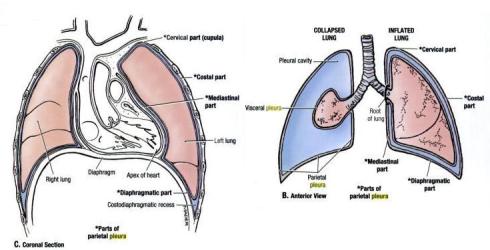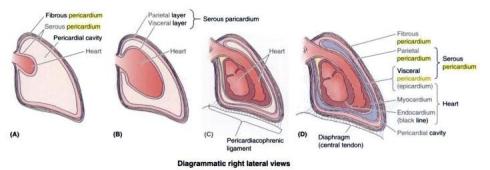14. The pleura and pericardium. Bone formation. Formation of the blastocyst and the bilaminar germ disc.
Flash cards:
Pleura 1
Pleura 2 - reflections
Pericardium 1
Pericardial reflections
Anatomy: The pleura and pericardium.
Pleura:
- serous membrane covering the Lung
- Double layer:
- Inner visceral – covers lung itself
- Outer parietal -covers inner surface of thoracic wall
- B/w 2 layers = Pleural cavity – 4 ml of serous fluid
- Function:
- lubricates the 2 pleural surfaces
- allows layers of pleura to slide smoothly over each over during respiration
- surface tension allows lung surface to stay touching thoracic wall
- Creates a seal b/w 2 pleural surfaces
- The two layers combine around the root of of the lung – so the root of lung has no pleural coverage, the layers combine to form the pulmonary ligament, which runs inf and attaches the root of the lung to the diaphragm
- CLINICAL NOTE: When parietal pleura is punctured, lungs collapse due to air rushing (air pressure higher outside than in) = pneumothorax

Pleural surfaces and recesses
Parietal Pleura – senses PAIN, lines inner surface of thoracic wall
4 parts:
- Cupula pleura (aka cervical pleura) – part of pleura which project above clavicle
- located w/in scalenus tent
- strengthened by a layer of endothoracic fascia call the suprapleural membrane = Sibson’s fascia
- Diaphragmatic pleura – faces domes of diaphragm inf
- , also separated from diaphragm via endothoracic fascia,
- only attached to lateral sides of diaphragm
- as central tendon of diaphragm attaches to pericardium
- Sternocostal pleura – attaches to rib and sternum
- separated from ribs via a part of endothoracic facsia called phrenicopleural fascia
- Mediastinal pleura – faces vert column and midline space b/w two areas of pleura = mediastinum
3 Pleural reflections: Lines where the surfaces of parietal pleura meet each other
- Sternal line = costal –> mediastinal (ant)
- Costal line = costal –> diaphragmatic (inf)
- Vertebral line = costal –> mediastinal (post)
* first 2 have a sharp,defined border, the last is a gradual rounded border
Nerve supply:
- IC n (sternocostal pleura, and peripheral part of diaphragmatic pleura)
- Phrenic n (central diaphragmatic pleura, and mediastinal pleura)
Blood supply = Int thoracic a, post IC, sup phrenic a, sup IC a
Visceral Pleura – sensitive to STRETCH, lines lung ext and dips into all fissures
Nerve supply = contains vasomotor fibers and sensory ending of CN X for respiratory reflexes
Blood Supply = bronchiol a, pulmonary v
Surface Projection:
- Lat – lat wall thorax = lat wall of pleura
- Sup = Cupula Pleura= dome of pleura,
- projects into neck
- above neck of 1st rib
- 2 cm above clavicle @ med end
- middle 1/3 clavicle b/w midclavicular line and midline
- Med border:
- R – R sternoclavicular joint –> desc to lower border of R 6th rib
- L – goes toward midline from apex, but never reaches it, follows the lung and desc down to 4th rib, runs a bit laterally and then comes back towards midline @ 6th rib, to form the pleural cardiac notch
- Inf border
- @ parasternal line – inf border crosses border of 6th/7th rib
- @ midclavicular line – inf border crosses 8th rib
- @ mid axillary line – 10th rib
- @ paravertebral line – T12, 11th rib

Surface Projection of Pleura
Pleural recesses:
If you notice, the surface projection of pleura is larger than the surface projection of the lung itself.
In between parietal pleura, are a series of recesses:
- Costo-mediastinal recesses – vertical in direction, costal & mediastinal pleura meet
- Phrenico-mediastinal recess – ant-post direction, b/w mediastinal & diaphragmatic pleura
- Costo-diaphragmatic recess – b/w costal & diaphragmatic pleura
- largest of the 3, horseshoe shaped,
- accumulates fluid when standing
- potential space that allow lung to expand into them when inhaling
- can collect sample of pleural fluid from here
- deepest point of sinus is @ mid-ax line where space b/w lung and pleura = 12 cm, or 4 fingers

Pleural Recesses
Pericardium.
strong fibrous layer, double walled sac w/ heart w/in
originates from intraembryonic somato and splanchno pleura
Layers of Heart itself: (sup –> deep)
- Fibrous pericardium –
- bound to central tendon of diaphragm for deep inspiration,heart follows diaphragm, so heart is more vertical,
- in deep expiration, heart rises due to upward movement of diaphram – heart is more horizontal
- Serous pericardium
- Has a parietal layer – stong dense reg CT, prevent heart from over dilating
- Visceral layer – simple squamous epithelium (mesothelium), that lines the heart itself aka Epicardium
- B/w 2 layers = Pericardial cavity
- Subepicardial CT
- Myocardium – muscular wall – striated cardiac m
- Subendocardial CT
- Endocardium – simple squamous epithelium (endothelium), same epith as blood vessels

Layers of Pericardium
Pericardium moves along w. movements of structures around it b/c:
- fused w/ tunica adventia of great vessesl entering/leaving heart
- attached to post surface of sternum by sternopericardial ligaments
- fused w. central tendon of diaphragm
Blood supply = mostly from pericardiophrenic a (int thoracic a) musculophrenic a (int thoracic a), bronchiol, esophageal, sup phrenic a (thoracic aorta), coronary arteries
Innervation = phrenic n (C3-C5), vagus n (CN X), SNS trunk
Reflections of pericardium: where 2 layers of pericardium meet each other

- @ arterial end – Transverse sinus
- where pul a and aorta leave heart,
- when doing surgery on aorta or pulmonary a, can stop circulation to this area by making a stitch through this sinus,
- reach by reaching under pulmonary trunk and ant to SVC
- where pul a and aorta leave heart,
- @ venous end – Oblique sinus =
- where SVC,IVC pulmonary v enter heart,
- reach via inserting finger under apex of heart and pushing up and right towards root of R lung
- where SVC,IVC pulmonary v enter heart,
Development of Sinuses:
- Form during embryonic life due to folding of embryonic heart tube
- As heart tube folds, venous end moves posterior and up, so venous end then is up by arterial end, separated by transverse sinus
- As veins of heart grow and expand, oblique sinus is formed, a recess, a blind sac behind post side of the heart,

Development of pericardium
Histology: Bone formation.
Embryology: Formation of the blastocyst and the bilaminar germ disc.
Blastocyst

- Image via Wikipedia
- fluid is secreted within the morula (16 cell) = blastocyst cavity
- now called blastocyst, and has 2 distinct cell layers
- inner cell mass = embryoblast –> is the future embryo
- outer cell mass = trophoblast –> will form the placenta
Bilaminar Germ Disk
Bilaminar Disc Formation:
- In the 8th day, the blastocyst has the inner cell mass & outer cell mass
- Each cell mass differentiated into 2 different cell layers
- Trophoblast = outer cell mass – splits into:
- Cytotrophoblast – inner layer of mononucleated cells – distinct cell barriers
- Syncytiotrophoblast – outer layer of mutlinucleated cells – no obvious cell boundaries
- cells are probably created in cytotrophoblast, and then migrate into syncytiotrophoblast
- Embryoblast = inner cell mass – splits into:
- Epiblast – layer of high columnar cells, next to amniotic cavity
- Hypoblast – layer of small cuboidal cells, next to blastocyst cavity
- small cavity forms in epiblast – is amniotic cavity , epiblast cells next to the cytotrophoblast = amnioblasts
- Cells at periphery of hypoblast migrate over inner surface of cytotrophoblast – forming thin layer extraembryonic endoderm = Heuser’s membrane
- Blastocyst cavity = is then called primitive yolk sac
- Uterus endometrium has interstitial edema (increased interstitial fluid b/w cells), and increased # of a/v

![Reblog this post [with Zemanta]](https://i0.wp.com/img.zemanta.com/reblog_e.png)
